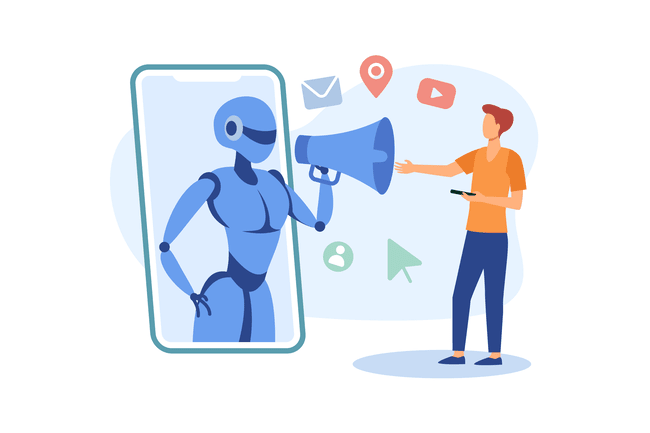People often think that the use cases for AI in media services are limited to recommending TV shows and movies to the customers, but that’s just the tip of the iceberg. From automated data production to content verification, AI has been providing for businesses and consumers throughout the different sectors of the media industry. Details Ahead!
Wouldn’t it be wonderful if your media business could receive data-backed insights regarding what kind of content your customers love to consume? And implementing these insights into your media broadcasting services would effectively improve the user’s experience and loyalty towards your services ten folds. Consider yourself lucky, because getting these insights with the help of an artificial intelligence model is now easier than ever.
The use of AI in media has deeply refined the process of providing consumers with a personalized experience. Not only that, with the help of a variety of AI services media platforms are able to generate and manage ungodly amounts of data in a super-efficient manner. This helps them to structure their content in a way that amplifies the engagement potential of your services, ultimately improving the retention rates of your customers.
As the use cases of artificial intelligence continue to grow every day, a large scale of media sectors has started to implement the technology on a number of business pain points. We will talk about them in the coming sections but first, let’s discuss what are the AI features that make this technology so useful for modern-day media!
Avail BinaryFolks’ Complementary AI Consultancy
Applications of AI in Media and Entertainment
If you compare people’s media consumption habits between today and a few decades ago, you will realize how much the industry has changed. In modern times, the common folks’ expectations from the media industry have grown exponentially as the tech advancements started stepping in consistently. Now people are much pickier about what they want to watch and are impatient about any inconvenience that may occur. Production houses are always under the constant pressure of delivering on-time results and that too with flawless accuracy, because with millions of eyes watching your real-time generated data, it is impossible to get away with even the slightest of mistakes.
This is where the use of artificial intelligence in the media starts to make sense. So, what exactly does AI do here? Primarily, pulls up process efficiency and accuracy, two key ingredients to satisfy consumers in the media and entertainment industry, to build a reputation & competitive advantage alike.

1. Automated Content Generation
Generating unique data is a time-consuming process, writers spend months writing the perfect script for a movie that the consumers can finish within a couple of hours. Being efficient with the data being generated is even more valuable when your field of work needs to generate data in real-time, like sports and journalism. Artificial intelligence is not just limited to generating textual data, companies have been developing models that use complex training data that helps AI to generate images, videos, and even voice notes based on the user's instructions. Unfortunately though, the scope for these content generation models were limited to basic text prompts previously, however the tech has come a long way since then. As things stand right now, an AI text to video tool can whip up a video of Bill Gates proclaiming his undying love for potatoes, in no time! Companies like OpenAI have been working on developing AI systems like Dall-E that operate around AI technologies like computer vision and deep learning.

2. Content Aggregation
The amount of content being generated across the media industry every hour can be overwhelming for a professional to extract important information that may be used for their media needs. The implementation of artificial intelligence in media services can take over the task of analyzing the constant flow of data and finding important data points & patterns based on your requirements. Not just that, artificial intelligence in media can simultaneously be used to filter out duplicates keeping the information clean and follow additional custom-set instructions to process the data. For example, think of setting up an AI-based news aggregation model that collects the latest data automatically and transforms it into a headline using automated content generation to make it super easy for the news reporter to convey the information about the events in real-time.

3. Metadata Tagging
If you own a business that has even the bare minimum link to media services, you know the humongous amount of data you have to deal with every day. Just storing this data without a proper structure in place will only cause more trouble to you in the long run. This is exactly where metadata tags come handy to label business data with relevant categories, making it easier to refer to them whenever necessary. However, manual tagging can be a major time killer and would leave ample room for human error. The smarter way to tackle this situation would be to implement an AI model that can automatically label your data. You can set up an AI model to tag songs on your music streaming platform on the basis of genre, title, year of release, and other relevant information to make sure the users can easily find the music they are looking for without any hassle.

4. Personalized Recommendations
Remember when you opened social media for the first time and it automatically recommended you to connect with your friends and neighbors just using the little information you provided in the initial form? Or the time when the app automatically suggested the exact people tag when you were uploading a picture with them? AI in social media uses machine learning, computer vision, and other AI technologies to analyze your demographics and the personal information you agreed to share to provide you with the most personalized media experience. As a business owner, you can capitalize on this personalization factor to provide your users with personalized media recommendations. These reports can be evaluated based on the data collected through the user’s content preferences, interactions with AI-enabled chatbots, and other previously mentioned aspects.

5. Content Authenticity Verification
It is highly unlikely that all the data that your business receives is authentic. However, manually checking the credibility of the data source or the data itself can be an impractical task, considering the amount of data that a regular business comes across on a daily basis. Artificial intelligence in media authenticity verification can help with analyzing whether a piece of content has been manipulated, altered, or changed in any way using deep learning services. Your business can implement these content verification solutions to ensure that the data being used for your business analytics and solution model training is reliable. Media sectors like news and advertisement are highly dependent on facts and credible sources to gain people’s attention. For them, dealing with an unreliable source of information for them can only lead to catastrophe.
.png)
6. Speech Recognition
Logging audio data in a structured format is an impractical task without the use of AI technologies due to the sheer amount of data the media industry generates every day. Speech recognition technology is used to process relevant information and generate content in real time directly from the audio data present. The stakeholders use speech recognition technology to improve the customer’s experience while they use the service. With the use of AI services like NLP and deep learning, organizations are able to transcribe the important points from business meetings to generate automated summaries for employees. With the implementation of this feature, employees can completely focus on the discussion at hand instead of scribing down the details, while losing track of the context of the discussion. Features like automatic subtitle generation have also made digital content in a foreign language much more accessible to the common people.

7. Sentiment Analysis
The media industry receives a lot of reviews on a daily basis, and people love to express their opinion on any new piece of media they just explored. However, you will rarely see people express their reviews directly on a company's portal, that is way too much effort. People would instead discuss their opinion with their friends and connections on social media platforms like Twitter, Instagram, IMDb, and others. Although this data is publicly available it might be a difficult task to track it down for further analysis, because the data is mostly present in an unstructured format and the language is not always machine-processable. With the implementation of artificial intelligence in social media these reviews can be filtered and processed by media corporations to get an idea of what the public opinion is about their latest production. The company can use this data to understand the key points of what they are doing right according to the people’s choices and the points where they need to improve.

8. Fraud Detection
No one likes unnecessary hate for their business, but at the same time, genuine constructive criticism is very important for a company’s growth. When looked at on a broader scale it is very difficult to differentiate between the two. The implementation of artificial intelligence in the media industry helps in reducing this confusion. Spammy profiles generally have a monotonous activity pattern, it may be for multiple companies or just yours. AI can easily filter these profiles to be blocked or reported according to the instructions provided. AI also helps media organizations to verify abnormal transactions, misinformation, and employee background efficiently to ensure that the workflow is not disrupted by any issues that could be avoided.
Discuss your AI Model with us!
Artificial Intelligence Across Different Media Sectors
The use cases for artificial intelligence in entertainment and media businesses have grown exponentially over the years. Businesses use AI services to make sure the consumers get the most immersive experience possible. Although AI is not yet capable of operating the media industry by itself it can surely speed up multiple processes and improve the accuracy of multiple media sectors. Let’s discuss a few of these use cases:

[a] Movies and Television
What are the expectations of a movie and television consumer?” This is a question every broadcasting company asks itself. The question seems to be super simple, and trust me so is the solution. People don’t want to be overwhelmed with a barrage of 100 movie options at once, that’s too much for anyone! By implementing AI solutions to your services, you can recommend customers with personalized show recommendations based on their watching habits. This is way more effective than throwing everything at them from the last genre of movie they watched. AI in entertainment businesses can also help production companies to generate their content more efficiently by helping with pre-production tasks like generating scripts and special effects, followed by assistance with targeted promotion.

[b] Music
Let me know if this conversation sounds familiar, “What was that song that goes?…” followed by the most bizarre combination of onomatopoeic words! Yeah, it is almost impossible for the other person to guess the song being referred to. Lucky for you, even with a vague set of instructions artificial intelligence is able to guess these songs pretty accurately. With the use of AI services like deep learning and NLP, machines can deduce these instructions and compare them with the historical search data of other similar instructions to provide the most probable result. That’s not all though, AI in media services has been helping music labels as well to write catchy and exciting lyrics, generate videos and so much more. Applications like Spotify and Apple Music use AI technologies to enhance the customer experience by recommending similar music and creating custom playlists automatically based on the songs they spend the most time listening to.
Within the AI-driven landscape, music's potential includes song creation with AI generation tools, transforming how melodies are composed and tailored for any mood or project. These advancements help creators by automating complex parts of music composition, making it easier to combine artistic intuition with AI-driven tools.

[c] Art
If you are the kind of artist that decides what they were drawing after they’re done with sketching, then congratulations! You’re not alone! However, with the help of AI, everyone can create art as long as they can imagine it properly. AI-based models like DALL.E use computer vision, natural language processing, and deep learning to create images based on the user’s instructions and the AI’s general understanding of the keywords being used. The amount of potential creativity these kinds of models possess can be seen by the amazing variety of content that people are generating every day. The art industry has other applications of AI in media restoration, several services have been using advanced AI solution models to restore old art pieces and pictures that carry a sentimental value for the customers.
.png)
[d] Gaming
If you know anything about video games, you would know how far they have come in the last decade. The visuals in some of the high-end games make you question whether what you’re looking at is real or is it something generated by a computer. AI has made the gaming experience much more immersive for the players, it can help in generating realistic environments by generating visuals and making the non-playable characters respond much more naturally. Almost every gaming industry giant has incorporated artificial intelligence in their media and video game development project to leverage the quality of their products. For example, many companies use artificial intelligence to analyze the user feedback of a group of people during their beta phase. They then work on fixing in-game bugs, optimization errors, and other improvements. Once they are absolutely satisfied with the result they push the content to the public.

[e] Journalism
The news broadcasting companies and the journalists that work there share a common nightmare, broadcasting the wrong piece of information! Journalism is a challenging profession, it demands you to share a piece of information faster than your competitors, and that too with absolutely no errors. The problem with journalism is that there are no take backs and with so many eyes watching your content in real-time every incorrect fact or inappropriate sentiment is noticed. Artificial intelligence in media has been helping with perfecting the content generation part to a large extent. Use AI to automatically aggregate relevant events and generate headlines in real-time while highlighting the tone of the news simultaneously with the help of technologies like deep learning and NLP.

[f] Advertising
Everyone hates unskippable ads on video streaming platforms. And they just seem to grow in number every day, as annoying as it may seem, it is one of the major sources of the content creator’s income. When televisions were the only source of visual entertainment the situation was way worse. People had to sit through an average of 10 minutes of advertisement during a 30-minute showtime. Even though companies have launched premium versions of their applications that do not have any advertisements whatsoever, a large chunk of people still use the standard versions. Even though the general norm is that advertisements are annoying, with a little bit of analysis the concept of advertisements can be completely changed.
Implementing AI in media and entertainment companies can run targeted advertisements based on the viewer’s watching habits and predictive analysis based on past client data, this can change people’s perception of advertisements from being annoying to being informative. Companies can also use AI to analyze the performance of multiple advertisements. Let’s consider a situation where two advertisements are launched at the same time by the same company, but it was observed that one of the ads is performing exceptionally well compared to the other one. In this case, the company can decide to pay just for the better-performing advertisement as the other one is not contributing towards the company’s promotion that much.

[g] Sports
Everyone hates unskippable ads on video streaming platforms. And they just seem to grow in number every day, as annoying as it may seem, it is one of the major sources of the content creator’s income. When televisions were the only source of visual entertainment the situation was way worse. People had to sit through an average of 10 minutes of advertisement during a 30-minute showtime. Even though companies have launched premium versions of their applications that do not have any advertisements whatsoever, a large chunk of people still use the standard versions. Even though the general norm is that advertisements are annoying, with a little bit of analysis the concept of advertisements can be completely changed.
One thing that is common across every sport is the time when the players put up their absolute best performance to win a contest. It is such a beautiful moment when a team or individual player beats the odds to win against someone they were not supposed to win. These stats are super important to build up the viewers’ hype, but it is pretty impossible to keep track of all the little details when the games are happening right? AI in sports has been a lifesaver when it comes to fishing out these little facts and information based on that sport’s historical database. AI can find out these facts as and when the events are happening and generates speakable sentences that the commentators can refer to while conveying the information. What this basically does is that it adds value to the moment and makes it memorable for the viewers. Like when LeBron the youngest player to score 25000 points by beating Kobe Bryant, the stats would have been difficult to fish out without AI’s assistance.

[h] Virtual and Augmented Reality
Imagine clicking a picture on top of the Eiffel Tower without actually going to Paris. Or maybe something a bit more extreme like skydiving from the comfort of your bedroom? I know it sounds crazy, but with the implementation of AI solutions in media like augmented and virtual reality all these things can be easily possible. VR and AR have been used across other media sectors to provide an experience that is much more immersive than the regular way of consuming media, that is through a flat screen. Viewers can experience the environment of the media they are watching by creating a virtual world around them that consists of detailed elements that are very close to the actual reality. Industries like sports, movies, and gaming take the most advantage of augmented and virtual reality.
The Future of AI in the Media Industry
According to a report, the media industry has been growing at a promising CAGR of 8.0% and has reached $2371.64 billion dollars by this year. With such a promising incline in market growth and with big-time investors getting involved with new artificial intelligence solutions, the future of AI in the media business looks bright.
AI might be limited to just providing assistance across the media industry at this point in time, but the truth is that within a few more years it might be capable of handling the entire production to promotion aspects by itself. Now, this has got some of the artists worked up about the fact that a machine can never replicate the human touch when it comes to making content that people can relate to. This is indeed true, however, the intention of AI was never to replace humans from the entertainment industries; the main goal has always been to improve the efficiency and accuracy of the content that passes through a business pipeline.
With the media industry giants like Netflix and Disney already implementing deep learning and computer vision technologies to generate mainstream media content, this is the right time to start designing your own AI-powered media project with BinaryFolks!
BinaryFolks’ Expertise With Artificial Intelligence in Media

(1) Personalize Your Customer Experience with BinaryFolks’ AI-driven Media Solutions.
Our AI developers can create custom AI models that can enhance the customer’s viewing and reading experience by recommending personalized content with a proper logical analysis instead of mindless content bombarding. We also help companies to tag their data in a structured way so that the customers have an easy time trying to find the content they want to watch. The process of finding the content they may like to watch is further enhanced using services like AI-powered chatbots and sentiment analysis.

(2) Use BinaryFolks’ AI solutions to Generate Accurate and Reliable Content Faster Than Any Human.
Our AI in media services can help media businesses to grow by optimizing major parts of their production-to-promotion process. This is possible by a simple 3-step solution model.
- First, take input from the stakeholders or anyone responsible for the kind of data that needs to be aggregated or generated.
- Second, generating data based on the information quickly while ensuring the facts in the data are reliable and accurate.
- Thirdly delivering the data to the right group of people to obtain the most efficient results.
.png)
(3) Get Assistance With Designing an AI model Customized for Your Media Business with BinaryFolks’ AI experts!
At BinaryFolks, we provide our clients with complimentary AI consultancy to help them understand the concepts of AI in the media industry and help them to sketch out their AI model with a touch of our industry expertise! Our developers use advanced AI technologies like NLP, computer vision, deep learning, and many more to provide our clients with cutting-edge solutions. This helps the media business to enhance its customer experience and efficiency while monitoring the production costs and public opinion for the long-term growth of the company.
Conclusion
Now that you’ve gone through everything there is to know about AI in media and entertainment let us recap the key takeaways in a jiffy before you start designing your AI model with BinaryFolks! (;
[a] AI Services To Upgrade Your Media Industry Game!
We discussed how consumer needs have changed over the years, the people want quality content served to them in the shortest possible time frame and with almost no flaws. The use of artificial intelligence in media has allowed businesses to keep up with the customer's needs by automating some of the workflow bottlenecks using modern solutions:
- Automated Content Generation
- Content Aggregation
- Metadata Tagging
- Personalized Recommendations
- Content Authenticity Verification
- Speech Recognition
- Sentiment Analysis
- Fraud Detection
[b] Applications of AI across the Media Industry
Applications of AI are not just limited to recommending shows to consumers that they may like. With proper implementation, AI can serve use cases spread across multiple media sectors including
- Movies and Television
- Music
- Gaming
- Journalism
- Advertising
- Sports
- Virtual and Augmented Reality
Design your Media Automation Model with BinaryFolks




.png)
.png)